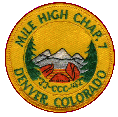Her CCC experience
A high school senior in 1935, I earned sufficient credit to graduate at mid-year. The school suggested I spend the last semester in a work experience and return for graduation at the end of the school year.How could a young lady begin a career during the Great Depression? I didn’t realize it then, but the Civilian Conservation Corps would be the most important step for me toward a federal career spanning 34 years. Here’s how my association with the CCC came about.
Winnebago, NE, my home town, was a mere village with no opportunity for adults, much less a teenager. But there was a U.S. Indian Agency on the outskirts of town which provided services to the Winnebago Indians, the most logical place to get a job. I applied, was offered work, but only as a volunteer. No pay was a disappointment, but believing the experience would be a valuable reference in the future, I accepted.
Graduating in June 1936, I prevailed upon the Indian Agency for employment, only to be told there were no jobs available. After a number of persistent visits, the superintendent finally told me, “You did excellent work as a volunteer. I will appoint you as an enrollee in our CCC Indian Division. Will you accept?” Ecstatic, I accepted. Pay would be $55 per month since no quarters or subsistence were provided.
Imagine my surprise when I was assigned to a warehouse where I would issue tools and supplies to CCC enrollees for their day’s work and meet them at day’s end for check-in. Some of these tools had strange sounding names but the CCC boys helped me to learn. In between, I worked on inventories, purchase orders, and correspondence. From June 1936 to September 1938, I trudged three miles over a dirt road to work, brown bag in hand, to take care of my duties. I held the rank of Leader when released.
A long career follows
I then took an accounting course, passed a U.S. Civil Service test, and received notification of appointment to a cost accounting position with a CCC unit, Bureau of Indian Affairs, Ft. Totten, ND. Again, I was with the CCC Indian Division but this time as a classified federal employee. I developed many friendships among the Sioux Indians. I was flattered and honored when they called me their White Flower. Leaving Ft. Totten in 1943 to help with the war effort, I transferred to Fitzsimmons Army Hospital, Denver. Remaining at Fitzsimmons after the war, I advanced to the position of Personnel Staffing Specialist, the position I held at retirement in 1972.
In 1982 I became aware of the National Association of CCC Alumni and local Denver Mile High Chapter 7, becoming a member of both. I served Chapter 7 as Vice-President and Treasurer. At the 1985 NACCCA convention I was crowned Queen of the NACCCA, an honor I treasure dearly. During the 1987 NACCCA convention, I was elected SW Region Director for a two-year term thus becoming the first woman ever to serve on the national Board of Directors. As Director, I traveled more than 20,000 miles and spent 1000 days on the road visiting NACCCA chapters. I would be remiss not to acknowledge the many awards bestowed upon me by SW Region chapters. My work was reminiscent of my days as a CCC enrollee dealing with a lot of men.
Wherever I traveled I came to expect the question, “What was it like to be in the CCC with more than three million men?” My answer, “It seemed as if I had somehow stumbled into paradise!” Most recently, I was appointed NACCCA Coordinator for Colorado, New Mexico, and Utah. Somehow, I can never relinquish my desire to serve the NACCCA or the personal satisfaction of dealing directly with CCC alumni.
The CCC gave me hope and opportunity when there was none. Whatever successes may have come in my life, I shall always remember the CCC was instrumental in preparing me to meet the challenges of life.
—From The Way We Remember It, by M. Chester Nolte
Although I never had the privilege of meeting Mildred, she was a long-time member of Chapter 7 until her death. Mildred exemplified the lifetime of service that seems to be typical of CCC alumni.







